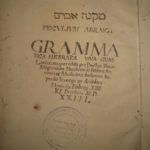Daniel Bombeg, Marco Antonio Giustiniani, Alvise Bragadin
During the early years of Venetian publishing, when the city rose “to the apex of European Hebrew publishing,” only one important Jewish publisher, Meir Parenzo managed to operate there. Despite repeated attempts, the man who has been called “the greatest Jewish printer of all times,” Gershon Soncino, never made it to Venice.
The first to print Hebrew texts in Venice was a Christian from Antwerp, Daniel Bomberg, who published the Hebrew Bible and the Talmud. He was not welcomed with open arms and had to struggle to obtain government permission to print in Hebrew. Only on his fifth attempt, and after shelling out some 500 ducats, is he granted a ten-year privilege.
Clearly, there was a golden barrier beyond which the religious scruples of the patricians were unable to go and, just as obviously, if Bomberg could afford to spend such a large amount, it means that he expected a considerable return on his investment.
In 1515 he set up a print shop, availing himself of the collaboration of a Jew-turned-friar, Felice da Prato, who made a request to the Venetian government “to take on as assistants ‘four well-instructed Jewish men’. The first works printed by Bomberg have been lost; they probably did not survive the book burnings of the Inquisition. In 1517 he released the first edition of the Hebrew Bible, which also contains the Aramaic tradition and commentary by celebrated Medieval Hebrew exegetes.
While working on the Rabbinical Bibles, Bomberg had the Talmud in mind. Its publication was supervised by Cornelius Adelkind, who prepared the edition of the Babylonian Talmud, printed in twelve volumes between 1520 and 1523, while the four volumes of the Jerusalem Talmud rolled off the presses between 1522 and 1523.
Bomberg’s edition of the Talmud was memorable “not only for its philological accuracy and the beauty of its characters, but for the layout of its pages”; it was destined to serve as a model for all subsequent editions.
In this brief span of years, the Flemish printer in Venice put out the first editions of some of Judaism’s most fundamental works. His business was much broader—as he worked on commission for “numerous communities of the Diaspora: Rome, Spain, Germany, and Greece, and as far away as Aleppo in Syria.”
In his thirty-two years of activity, between 1516 and 1548,“the Aldus of Hebrew Books”—as Bomberg came to be called with a reference to Also Manutius, was recognized as “the greatest of the great” and printed more than 180 works.
He used excellent-quality paper, with a filigree of an anchor inscribed in a circle crowned by a star. Paper yellowed by time but is still robust and substantial. He also worked in the international market printing pocket-size prayer books for the Sephardic communities.
An important figure in Bomberg’s shop was Eliyyah ben Asher ha-Levi Askenazi, better known as Elia Levita, who, having fled Rome, from 1528 to 1549, worked in the printing shop as “advisor, editor, and proofreader.”
Levita was the first to establish that the dots used to indicate vowels are not as ancient as the Hebrew alphabet, as was then commonly believed, but an innovation introduced only in the fifth century of the Christian era.
For this reason, he had Bomberg print on the inside of the grammar a little hand with a pointing index finger which, as explained in the introduction, is a way of saying, “Look, this is something new.”
The story of Venetian Hebrew printers continues with Marco Antonio Giustiniani, a Venetian patrician who established a printing house at the Rialto, in Calle dei Cinque. He remained in business for seven years, from 1545 to 1552, and, using the Temple of Jerusalem as his emblem published eighty-six editions.
The quality of Giustiniani’s books was first rate, also thanks to his hiring of some of Bomberg’s collaborators and his use of characters engraved for him by the most celebrated punch-maker of the time, the Frenchman Guillaume Le Bé, who arrived in Venice in 1545.
The Bragadin printing house made its debut with an edition of the Mishne Torà, by Mosé Maimonide, with commentary by Meir Katzenellenbogen, a German Rabbi who had studied in Prague, and a representative of the Paduan anti-cabalists.
At almost the same time and in competition with Bragadin, Giustiniani printed the same codex without Rabbi Katzenellenbogen’s commentary.
The two entered a battle. The former accused the latter of unfair trade practices in the printing of the Talmud. A rabbi from Prague became involved in the dispute and called for help from the highest authorities of the time. Rabbi Moses Isserles from Krakow, after a careful investigation, threatened to excommunicate all those who had purchased the edition printed by Giustiniani who appealed to the papal authorities to condemn Bragadin’s edition.
If he’d had any idea of the consequences that this move would provoke—shutting down the presses, suspending Hebrew publishing in Venice for the next ten years, and the end of Venice’s hegemony in this sector—he almost certainly would have thought better of it.
Marvin J. Heller, Further Studies in the Making of the Early Hebrew Book, 2013, Giuliano Tamani, Di alcuni stampatori in ebraico a Venezia nei secoli XVI-XVII-XVIII, 2015, Joseph R. Hacker (Editor), Adam Shear (Editor), The Hebrew Book in Early Modern Italy, 2011



